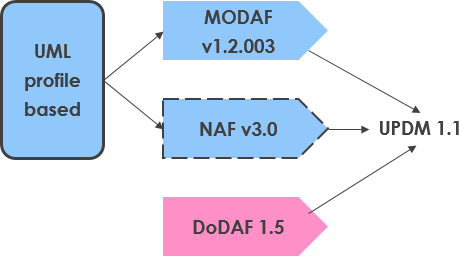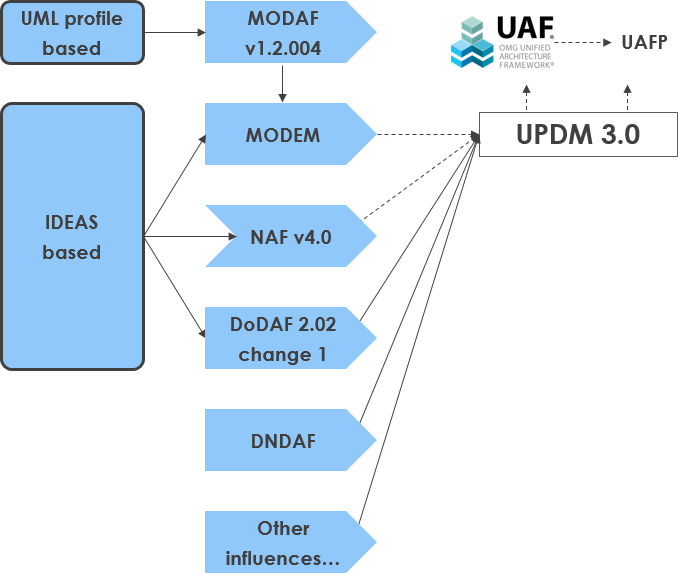The Unified Architecture Framework (UAF) is based on UPDM 3.0 and the UML/SysML in military communities. Value propositions are to develop standardized and consistent enterprise architectures based on the U.S. Department of Defense Architecture Framework (DoDAF) and the UK Ministry of Defence Architecture Framework (MODAF) and as well as the NAF (NATO Architecture Framework). UAF defines ways of representing an enterprise architecture that enables stakeholders to focus on specific areas of interest in the enterprise while retaining sight of the big picture.
UAF meets the specific business, operational and systems-of-systems integration needs of commercial and industrial enterprises as well as the most current version of:
The Unified Profile for DoDAF/MODAF (UPDM) is a UML Profile (customization package) that provides a consistent, standardized means to describe DoDAF, MODAF and NAF architectures in UML-based tools as well as a standard for interchange.
UPDM is based on OMG’s Unified Modeling Language (UML) 2.0, Systems Modeling Language (SysML), and Service-Oriented Architecture Modeling Language (SOAML), ensuring widespread implementation by multiple tool vendors. Although DoDAF and MODAF were initially developed for the military domain, the Enterprise Architecture issues they address are equally applicable to many general business and public service systems. Therefore, UPDM is also finding widespread use amongst companies and government organizations that implement DoDAF and MODAF.
The goals of UPDM are to significantly enhance the quality, productivity, and effectiveness associated with enterprise and system of systems architecture modeling, promote architecture model reuse and maintainability, improve tool interoperability and communications between stakeholders, and reduce training impacts due to different tool implementations and semantics.
In March 2008, the UPDM Group was re-formed by members of INCOSE and the OMG to create the Unified Profile for DoDAF and MODAF (UPDM) using UML/SysML. Members of the UPDM Group were tool vendors, members of industry and representatives from the US DoD, British MOD, NATO, Canadian and Swedish armed forces. The Figure shows below the evolution and relationships between DoDAF, MODAF, DNDAF, and NAF.

UAF architecture models provide a means to develop an understanding of the complex systems and the relationships that exist between organizations, systems, and systems-of-systems and enable the analysis of these systems to ensure that they meet the expectations of the user community.
UPDM was developed in response to a need from the UML/SysML and military communities to develop standardized and consistent enterprise architectures based on the U.S Department of Defense Architecture Framework (DoDAF) and the UK Ministry of Defence Architecture Framework (MODAF).

The OMG UAF is the next stage in the development of UPDM; it takes the principles of UPDM and extends it to reach a wider audience. As well as encompassing DoDAF, MODAF, and NAF, UAF also includes views that can capture human-machine interface and human factors concerns, security analysis, and systems-of-systems lifecycle concepts. Because of this expansion in scope, it became necessary to change the way views were represented in UPDM.
This resulted in the definition of a grid-based approach that separates the meta-model from the view specification and a specific architecture framework representation.